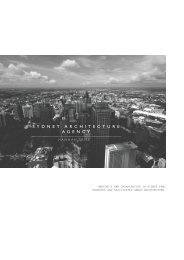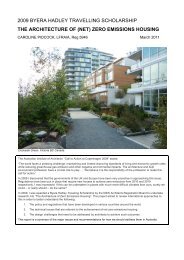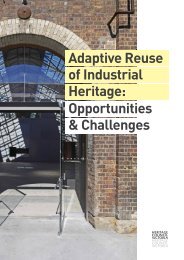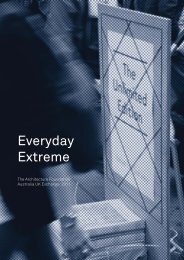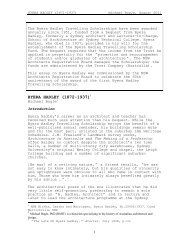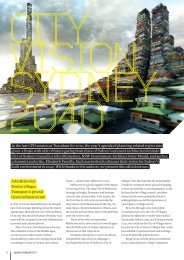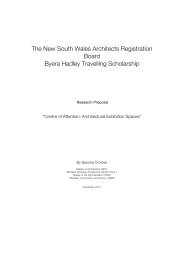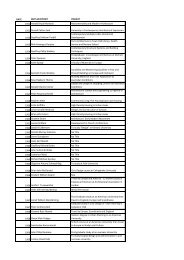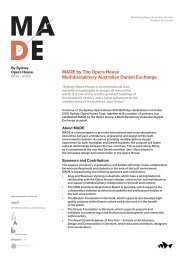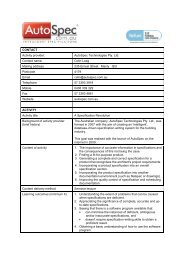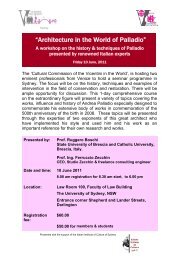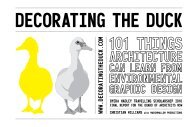spatial experience narrative and architecture - Architecture Insights
spatial experience narrative and architecture - Architecture Insights
spatial experience narrative and architecture - Architecture Insights
Create successful ePaper yourself
Turn your PDF publications into a flip-book with our unique Google optimized e-Paper software.
SPATIAL EXPERIENCE, NARRATIVE & ARCHITECTURE - BYERA HADLEY REPORT 193.0 PRACTITIONERS OF THE IN-BETWEEN3.3 Narrative: Re-imagining <strong>Architecture</strong><strong>and</strong> the role of the ArchitectFilm + <strong>Architecture</strong> is an emerging discipline.Commissioners in each discipline are naturallynervous at the idea of someone working in betweentwo disciplines. Christophe Gérard expressed,that as a practitioner “one moves between thesedisciplines with difficulties. So my work tends tobe, at times, purely architectural, at others, purelyfilmic. Having said that, I have a filmic approach to<strong>architecture</strong> <strong>and</strong> an architectural approach to film -my knowledge in one domain enriches the other.” 26In the face of such limitations within the profession,how might practitioners critically revise the role ofthe architect, <strong>and</strong> operate in an exp<strong>and</strong>ed field ofarchitectural activities?Liam Young is an urbanist, architect <strong>and</strong> curatorwho currently lives <strong>and</strong> works in London. He isinterested in the way one uses a design project toput abstract ideas together <strong>and</strong> launch a project asa <strong>narrative</strong>. Liam is a founder of the futures think tank‘Tomorrows Thoughts Today’, a group whose workexplores the consequences of fantastic, perverse<strong>and</strong> underrated <strong>architecture</strong>s <strong>and</strong> urbanisms. Liam isalso a design lecturer coordinating at the AA, Bartlett,Chelsea College of Art <strong>and</strong> other schools throughoutEurope <strong>and</strong> Asia. His studios are positioned in theprojective worlds of speculation <strong>and</strong> fiction <strong>and</strong>become critical instruments for instigating debateabout the cultural consequences of emergingbiological <strong>and</strong> technological futures. 27Liam draws upon his Architectural education towork as a Designer, on architectural projects <strong>and</strong>‘architecturally informed’ projects with a rangeof applications. This takes form as Art, curation,<strong>architecture</strong>, teaching <strong>and</strong> event moderation. Hesuggests this exp<strong>and</strong>ed field of architectural activitiesis “one voice with many outputs.” 28 He seeks differentforums to address the same problems, to engage inproductive discussion <strong>and</strong> debate.Liam looks at different ways the Architect canoperate as a Designer & provocateur outside builtpractice. He stated, “the value of this speculativeprocess <strong>and</strong> projects is judged on how it filtersdown into the built world, <strong>and</strong> how it generates adiscussion. In addition, The Architect might usethis technique, these interventions, as a way tounderst<strong>and</strong> emerging technologies in this context<strong>and</strong> to review problems in a new way.” 29One such project Liam co-ordinated was ‘Winter2011_Strange times_far North Alaska: 0–180ºlongitude” as part of “the Unknown Fields Division.’ 30The Unknown Fields Division is a nomadic designstudio that travels on annual expeditions to theends of the earth exploring unreal <strong>and</strong> forgottenl<strong>and</strong>scapes, alien terrains <strong>and</strong> obsolete ecologies:“The otherworldly sites we encounter afford usa distanced viewpoint from which to survey theconsequences of emerging environmental <strong>and</strong>technological scenarios”(Unknown Fields Division). 31They annually navigate a different global crosssection <strong>and</strong> map the complex <strong>and</strong> contradictoryrealities of the present as a site of strange <strong>and</strong>extraordinary futures. The division mission states:“we are both visionaries <strong>and</strong> reporters, partdocumentarian <strong>and</strong> part science fiction soothsayersas the otherworldly sites we encounter afford usa distanced viewpoint from which to survey theconsequences of emerging environmental <strong>and</strong>technological scenarios.” 32Liam’s design methodology promotes the tools offiction <strong>and</strong> speculation to engage with urban <strong>and</strong>ecological problems in a real way in the present,as opposed to imagining a future. While thesespeculative projects are quite fantastical, this methodof designing ‘interventions’ <strong>and</strong> drawing comparisonsbetween ecological <strong>and</strong> urban environments hasthe ability to reveal particular problems <strong>and</strong> potentialsolutions via subtle fabrications <strong>and</strong> iterations.PICTUREDUnknown Fields DivsionProject imagesImage source:http://www.unknownfieldsdivision.com/



